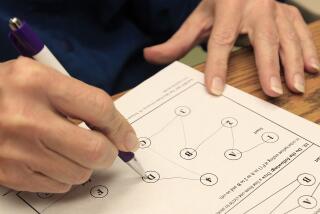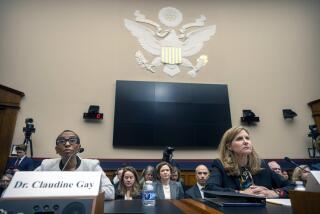Testing for ‘Unconscious Prejudice’
- Share via
SEATTLE — Researchers at the University of Washington and Yale University have developed a new tool to measure people’s “unconscious prejudice.’
They cautioned that results from the Implicit Association Test--that unconscious prejudice occurs in nine of 10 people--could be disturbing, especially among those who consider themselves prejudice-free.
The researchers, psychology professors Anthony Greenwald of the University of Washington and Mahzarin Banaji of Yale University, recently activated a World Wide Web site that allows people to test their own levels of inadvertent prejudice and stereotyping.
People who take the test “either say ‘Oh, my God,’ or they say ‘I don’t believe it,’ ” Banaji said. The ingrained prejudices, she said, appear to be cultural influences learned over the course of a lifetime.
Greenwald said he was especially bothered to find the test uncovered subtle prejudices in himself, along with virtually everyone else who takes it. And he fully understands those who don’t want to hear that message, he said.
“I really don’t believe I’m prejudiced, but I believe I have what I conveniently describe as the unconscious roots of prejudice,” Greenwald said.
The test, which Greenwald said was an outgrowth of other established techniques in social psychology, measures “implicit attitudes”: positive or negative thoughts about one object that are powerful enough to rub off on associated objects. As an example, a person may have a positive view of a company because a loved one works for it.
Frequently, Banaji and Greenwald say, people are completely unaware they have such attitudes, which can be the exact opposite of a person’s stated or “explicit” views.
The Web site (https://depts.washington.edu/iat/) offers four tests, measuring unconscious prejudices of black versus white people, old versus young, gender stereotypes and self-esteem--whether there’s an automatic preference for oneself.
In the race test, which is typical of the four, participants are asked to classify as quickly as possible a list of names into those that are most often considered black, such as Jamal or Lashonda, and those most often considered white, such as Chip or Peggy. Next, they are asked to rapidly classify a list of words as “good” in meaning, such as love and happy, or “bad,” such as war or evil.
Participants then are timed as they group the names and words into two new lists: white names and good words, and black names and bad words. The test is then switched: participants group white names and bad words, and black names and good words.
While on the surface the final two tests appear equally difficult, in nearly all cases, Banaji and Greenwald say, people take longer when grouping black names and good words than when grouping white names and good words. That, they say, indicates an automatic, unconscious preference for white names.
The latent prejudices appear stronger among whites and Asians than among blacks, Banaji said, though more research is being done on variations in responses by non-whites.
Tests, including one administered to 1,300 incoming freshmen at Yale, have consistently found unconscious prejudices in 90% to 95% of participants, the researchers said.
Tests were checked to see whether the order of questions, name or word familiarity or other factors affected how people responded, but the results remained much the same. In some cases, the names were replaced with pictures of black or white faces.
“We believe it reveals something that is pretty uncontrollable,” Greenwald said.
Curtis Hardin, an associate professor of psychology at UCLA, has been using the test both in research and teaching.
“I use it as a class demonstration and it never fails,” Hardin said.
While there are other tests that demonstrate prejudice, “this is a beautiful, elegant way of showing it because people can see it happening themselves,” he said.
A description of the Implicit Association Test was published earlier this year in the Journal of Personality and Social Psychology, and Banaji and Greenwald say it’s being rapidly adopted as a tool by other researchers.
Among such projects underway is a study in Germany of prejudice between Bavarians and North Germans, research at Northwestern University into attitudes toward the overweight, studies at Yale on identity, favoritism and self-esteem among black Americans and white Americans, and research at the University of North Florida on attitudes toward mathematics by elementary teachers.
Scott Ottaway, an assistant psychology professor at Western Washington University, tested whether subjects’ familiarity with the words used in the list affected results.
For white undergraduate students taking the racial prejudice test, “basically, what we found are even stronger effects” when adjustments were made for how familiar the students were with the words and how often they had seen them, Ottaway said.
“Once you’ve equated all those factors, there’s really no alternative explanation other than people associate white names with pleasant words and black names with unpleasant words,” he said.
Ottaway said it’s too early to tell whether the test can be used to predict an individual’s behavior.
“This is a very important qualification,” he said. “It appears these biases are automatic, but it doesn’t mean they can’t be overcome.”
Because of that, Greenwald and Banaji caution that the test has potential for being misused outside of research laboratories. They especially are worried that it could be used to screen people for jobs or to try to probe people’s unconscious likes or dislikes.
The goal of the new Web site is not so much fostering research as it is self-awareness. People who take the tests via the Internet don’t have to identify themselves or necessarily tell the truth in their responses, Greenwald said. Although some statistics will be kept on the Web site, there are no plans at present to use the data or the site for research, he said.
“Right now, we want to use the Web site as a place to educate people about themselves,” Banaji said.
“There’s an old-fashioned term--consciousness-raising,” Greenwald said.






